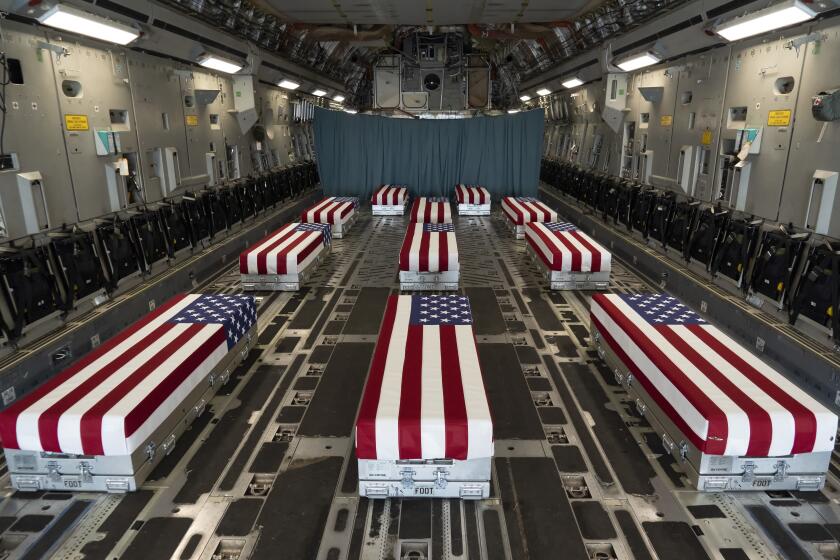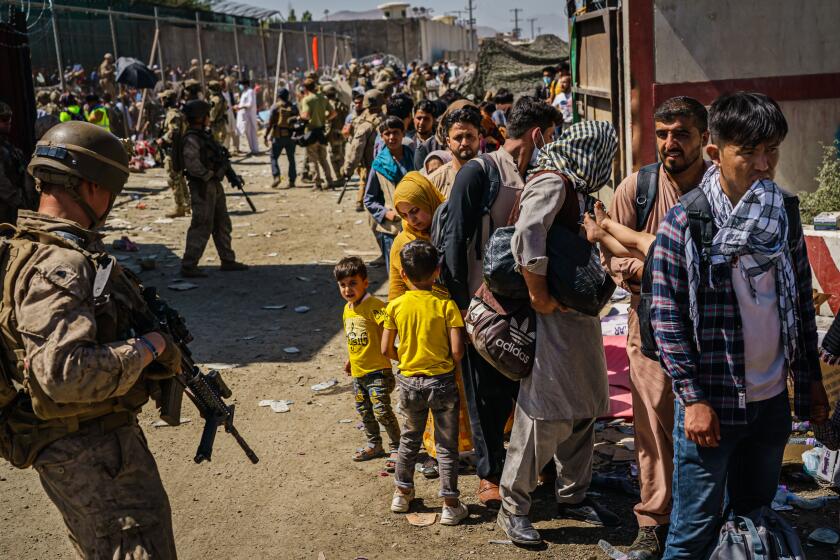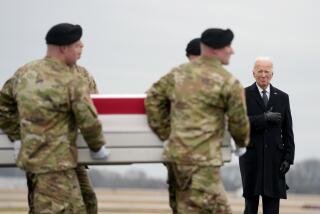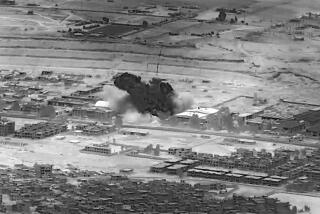U.S. strikes Islamic State in retaliation for Kabul bombing
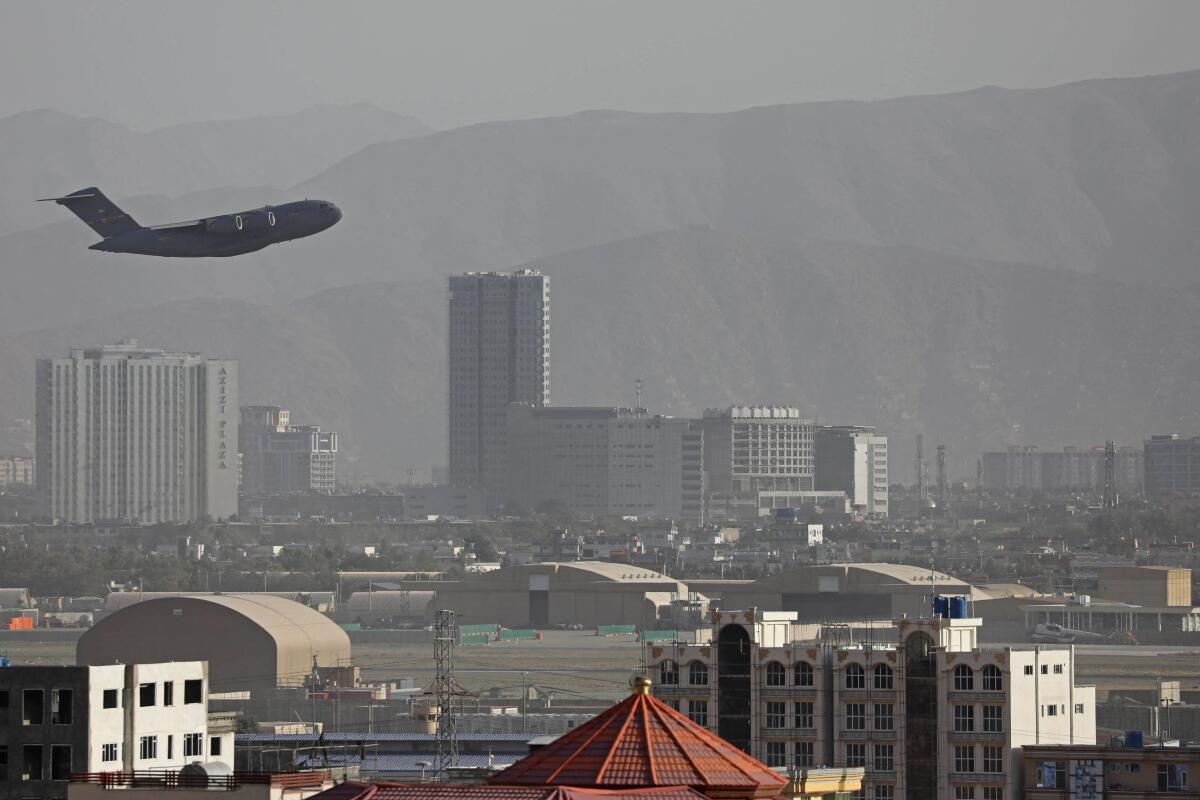
WASHINGTON â The United States launched a retaliatory airstrike Friday against Islamic State militants in Afghanistan believed responsible for one of the deadliest days for U.S. forces and Afghan civilians in the countryâs 20-year war, killing a âplannerâ of Thursdayâs airport bombing.
Making good on President Bidenâs pledge to hunt those responsible for Thursdayâs attack and make them âpay,â the military used a drone to target a militant in Afghanistanâs Nangarhar province, U.S. Central Command spokesman Capt. Bill Urban said in a statement.
âInitial indications are that we killed the target,â Urban said. âWe know of no civilian casualties.â
The strike followed the airport attack by an Islamic State affiliate known as ISIS-K, which killed 13 U.S. service members and scores of Afghan civilians â and came as the Biden administration warned of credible threats of additional terrorist attacks. The U.S. Embassy early Saturday, for the third time in as many days, warned Americans to avoid the Kabul airport gates because of possible suicide or car bombs.
Biden had vowed the day of the suicide bombing that the U.S. would seek retribution. âTo those who carried out this attack, as well as anyone who wishes America harm, know this: We will not forgive. We will not forget. We will hunt you down and make you pay.â
The speed of the retaliation will, ironically, cheer the Taliban as it consolidates its control of Afghanistan. The Taliban is a longtime rival of ISIS-K, which is named for Khorasan, an ancient province that once included parts of Afghanistan.
President Biden and First Lady Jill Biden are at Dover Air Force Base as the bodies of troops killed in the Kabul airport attack return to the U.S.
The main Islamic State group had invaded much of Syria and Iraq before being beaten back by U.S. forces in the last couple of years. ISIS-Kâs bombing of the Kabul airport embarrassed the Taliban, which is trying to show that it can govern and maintain security.
The airport attack also underscored the fertile environment for terrorism that Afghanistan is likely to become once Western troops complete their withdrawal Tuesday.
As it rushes to carry out the final evacuations of Americans and Afghan allies from Afghanistan, the U.S. military is attempting to piece together how Thursdayâs suicide bomber penetrated security. The Pentagon said earlier it had determined that there was one suicide bomber and a single blast â not two explosions, as it first reported. The Pentagon blamed its initial erroneous report â that a second bomb had exploded near a hotel outside the airport â on the confusion surrounding the incident.
Because of the crush of people at the entry to the Kabul airport, the death toll was unusually high. Most of the 13 U.S. service members killed were Marines, according to a Marine Corps spokesman. Hospital officials revised the Afghan civilian count to well over 150. The British government said three of its citizens â two adults and a child â were killed in the blast.
âClearly there was a break in the security processâ set up to screen people arriving at the Kabul airport, White House Press Secretary Jen Psaki said Friday. Part of that process is in the hands of the Taliban, which controls the airportâs perimeter. U.S. military commanders have asked Taliban leaders to widen that perimeter for better security, but it was not clear whether they have done so.
Two Marines from Riverside County are among those killed in a suicide bombing attack at Kabul airport, officials have confirmed.
Both the White House and the Pentagon said the window on evacuations was closing ahead of Tuesdayâs deadline for the withdrawal of U.S. troops. Psaki said to expect the number of evacuees to decline. Pentagon spokesman John Kirby said his office would no longer disclose the number of U.S. troops in Kabul out of security concerns.
In the White House briefing earlier Friday, Psaki was asked if Bidenâs pledge to make the terrorists âpayâ meant he wanted them killed or merely captured. âHe does not want them to live on the Earth anymore,â she answered.
Both the White House, after a briefing from top national security officials, and the Pentagon said another terrorist attack targeting the airport or U.S. forces was âlikely,â based on âspecific, credibleâ threats. âThe next few days of this mission will be the most dangerous period to date,â Psaki said.
The State Department said it expected to remove most of the U.S. diplomats still in Kabul over the weekend and has not decided whether to recognize a Taliban government. Spokesman Ned Price said the Taliban leadership has asked the U.S. to maintain a diplomatic presence in Afghanistan, but the administration wants to see if the Taliban keeps its commitments to follow international rules on human rights, counter-terrorism and other issues.; there are doubts among Afghans and the international community that it will do so.
Afghanistanâs best and brightest are leaving the country in droves, taking with them skills and knowledge that the Taliban wants put to its service.
Price also said officials were in contact with about 500 U.S. citizens still in Afghanistan who want to leave. The U.S. military has already airlifted 5,100 Americans, and âseveral hundredâ U.S. citizens have not decided whether to leave, he said. Price also said the âvast majorityâ of Afghan staff members from the U.S. Embassy, who in recent days complained of being left behind, have been located, airlifted out of Kabul or transported to the airport.
Since the end of July, U.S. and NATO forces have airlifted more than 110,000 people out of Afghanistan, including 12,500 in the last 24 hours â fewer than in recent days â but thousands more Afghans are likely to be stranded. Many are desperate to leave because their ties to the U.S. or Western entities, or their championing of Western values such as womenâs rights, put them in the Talibanâs crosshairs.
Gen. Glen VanHerck, who heads U.S. Northern Command, said more than 7,000 Afghan refugees have moved into four U.S. military bases in Texas, Florida, Wisconsin and North Carolina for temporary resettlement. He said there is now room for 20,000 in barracks and tents, and housing was being added to eventually shelter 50,000. He said the military was providing healthcare, religious services, three halal meals a day and a 24-hour âculturally appropriate grab-and-go.â
Times staff writer Chris Megerian contributed to this report.
More to Read
Get the L.A. Times Politics newsletter
Deeply reported insights into legislation, politics and policy from Sacramento, Washington and beyond. In your inbox three times per week.
You may occasionally receive promotional content from the Los Angeles Times.
